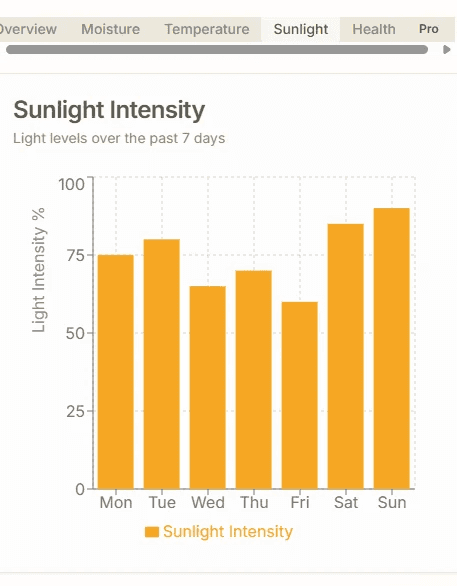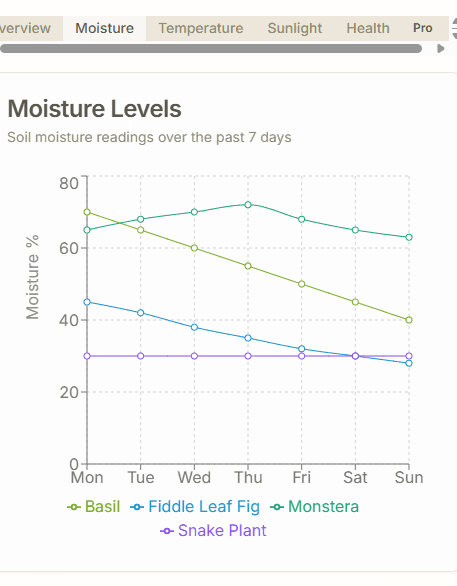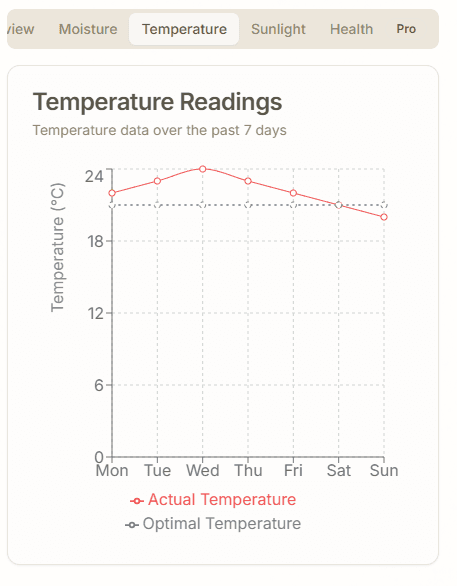

The Brief
Design Question | How might we design IoT systems that empower people to cultivate deeper, emotionally resonant relationships with their plants, moving beyond functional automation into embodied, ritualistic care? |
Brief | NaturOS is an IoT system that explores how embodied interaction and AI can foster deeper, more intuitive connections between people and plants. Moving beyond dashboards and raw data, the system reframes plant care as a meaningful ritual through smart sensing, haptic cues, and a connected digital platform. |
Result | Research + IoT prototyping + AI/ML + UX/UI + embodied interaction + speculative design. |
Methods | IoT device with soil, light, and temperature sensors + haptic and sonic feedback + AI-powered plant identification + React-based dashboard and plant library. |
Framing
Problem | Daily interactions with technology often distance us from natural cycles and living systems. In the context of plant care, most IoT tools reduce relationships to functional monitoring, leaving users disengaged and prone to “smart device fatigue.” |
Definition | NaturOS repositions IoT as a medium for empathetic, embodied interaction. Rather than automating plant care, the system supports presence, awareness, and ritual — making plant needs felt and understood in intuitive, human-centered ways. |
The Outcome | NaturOS integrates two complementary components:
Together, these elements create a system where care feels embodied, visible, and connected. |

Identifying Unique Challenges
Engagement Fatigue – users abandon smart devices that feel purely functional.
Over-Datafication – raw sensor data without context alienates non-technical users.
Disconnection – dashboards separate plant care from physical interaction.


Research Process
The project was developed over three weeks through a research-through-design approach:
Research: Reviewed literature on biophilic interaction design; interviewed plant owners to identify pain points.
Prototyping: Built hardware using ESP32 sensors, camera modules, and haptics.
Software Development: Developed a React-based dashboard with plant identification via AI/ML models.
User Testing: Iterative sessions shaped both the feedback modalities (vibration, sound) and the dashboard UI.

The Solution
NaturOS integrates two complementary components:
IoT Device – Senses soil moisture, light, and temperature, while providing subtle feedback through haptics and sound.
Digital Dashboard – A web-based interface where users can:
Track plant health and growth over time
Auto-journal watering and care history
Identify plants via AI image recognition
Build a personal plant library with profiles and tips
Together, these elements create a system where care feels embodied, visible, and connected.




Value Delivered
NaturOS is both an IoT device and a web platform that supports plant lovers in building a more mindful connection with their plants.
The device monitors soil moisture, light, and temperature, and communicates plant needs through sound, light, and haptic feedback — not just dashboards.
The web platform provides plant identification, care insights, and a growing library of species with personalized plant profiles.
Together, these tools encourage people to care for their plants more effectively while also cultivating empathy and appreciation for nature.



Reflection
NaturOS demonstrates how IoT can move beyond efficiency, shaping interactions that are ritualistic, empathetic, and sustainable. Future work could expand the system to community gardens or integrate collective features where users share plant stories.
At its core, NaturOS is not only about healthier plants—it is about healthier relationships between humans, technology, and the natural world.

Ethical Considerations
As with all IoT and AI systems, NaturOS raises ethical questions around dependency, privacy, and accessibility. A key concern is whether users may become overly reliant on the system to care for their plants, potentially diminishing their natural observational skills. NaturOS addresses this by framing itself as an aid rather than a replacement, encouraging presence through subtle cues rather than automated interventions.
Data privacy is also central: plant health data, images, and usage patterns must be handled with care, stored securely, and never repurposed without consent. Accessibility remains a guiding principle, ensuring the system is usable across different levels of technical literacy, and inclusive for users with sensory impairments by providing multimodal feedback (visual, sonic, haptic).
Ethical design in NaturOS prioritizes user autonomy, transparency, and long-term sustainability. Ongoing user testing and stakeholder feedback will continue to refine these principles.
References
Haeusermann, Tobias, et al. “Digital Plants and IoT in Everyday Life: Rethinking Care Practices.” Journal of Human–Computer Interaction, vol. 37, no. 6, 2022, pp. 543–560. https://doi.org/10.1080/07370024.2022.2101223
van Kemenade, P., & van der Voort, H. “Designing Sustainable IoT for Home Gardening.” Proceedings of the ACM on Interactive, Mobile, Wearable and Ubiquitous Technologies, 2021. https://doi.org/10.1145/3448129
Bhadra, S., & Dey, A. “IoT-Based Smart Plant Monitoring System.” International Journal of Computer Applications, vol. 183, no. 29, 2021, pp. 25–31. https://doi.org/10.5120/ijca2021921598
Calvo, Rafael A., & Deterding, Sebastian. Positive Computing: Technology for Wellbeing and Human Potential. MIT Press, 2019.
Sterling, Bruce. “Design Fiction: A Short Essay on Design, Science, Fact and Fiction.” Interacting with the Future, 2012. (Conceptual grounding for speculative design in NaturOS.)
Teachable Machine by Google. (2024). “A Web-Based Tool for Training ML Models.” https://teachablemachine.withgoogle.com
Hugging Face. (2024). “Open-Source Machine Learning Models.” https://huggingface.co
Espressif Systems. (2024). “ESP32 Technical Documentation.” https://www.espressif.com/en/products/socs/esp32




